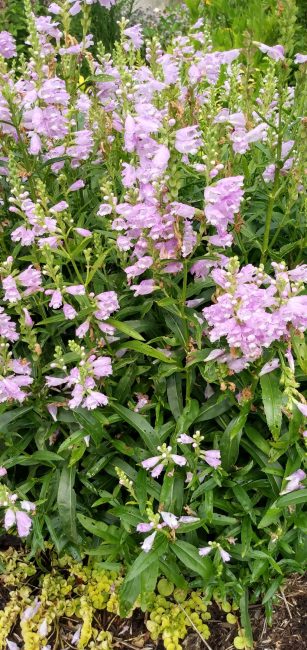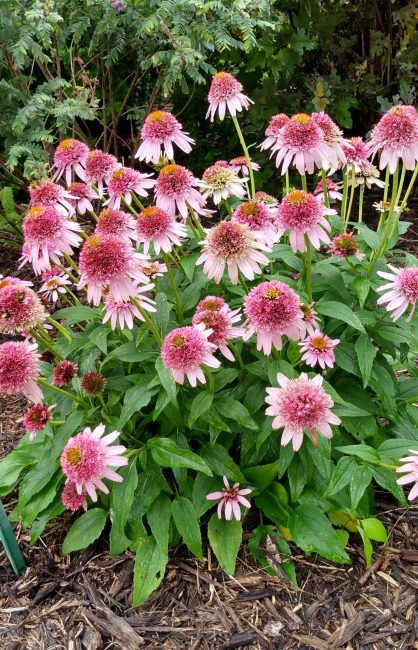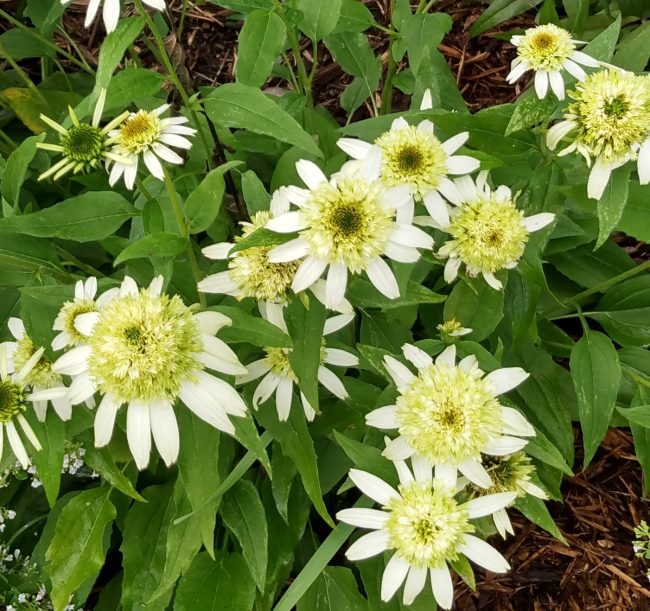‘Native’ is a bit of a slippery term, though you hear it used on a regular basis in reference to plants. But the question is, “Native in reference to where?”. When talking about ‘native’ plants, someone might be referring to a U.S. native or East coast native, but not necessarily a Midwest native or Wisconsin native or Dane County native. Some Midwest natives are not necessarily Wisconsin natives, or they may be widely scattered in Wisconsin.
Here is an example. People often refer to purple coneflower (Echinacea purpurea) as ‘native’ in Wisconsin. They also refer to pale purple coneflower (Echinacea pallida) as native. Are they both right? Well, it can depend on what authority you listen to and on whose native range map you are looking at, which is a lot more complicated.



The authority that I rely on is BONAP, the Biota of North America Program. In Dane County and a few nearby counties, our native coneflower is pale purple coneflower, (Echinacea pallida), according to the BONAP map below, but it has has the species in yellow here indicating it is ‘present and rare’. In other parts of the state it is dark green meaning ‘present and native’. If you look at the BONAP map below of purple coneflower (Echinacea purpurea), in most of the state it is ‘present and native’, but in Dane County and a few nearby counties, BONAP shows it in a teal color, meaning it is ‘native but adventive in the state’.
The term “adventive” refers to a native plant that is native to North America but is also present in a state outside its original native range. This happens when a plant has been intentionally or unintentionally introduced to a new area through human activity. We have a lot of weeds of European origin brought over at the time of settlement, but humans also moved native plants around. Adventive species often do not survive well outside their native range, but they may become self-sustaining in their new location, become ‘naturalized’ and widespread (or stay in scattered areas). This would be the case with purple coneflower.
Does any of this make a difference? Well yes, if you are trying to faithfully reproduce a particular ecosystem (for example a savannah in Dane County) that existed pre-settlement for a restoration area, versus planting a pollinator garden with ‘natives’ where you are not trying to recreate anything.
So now we have another wrinkle, and it relates directly to home gardening where you perhaps are trying to create a ‘native’ pollinator garden. Humans are always trying to improve on nature, and we do this by plant breeding. In vegetables, consider the humble carrot. Carrots are thought to have originated in the area near and in present day Afghanistan. Since the root is edible, breeding began to make it bigger and more palatable. Carrots were cultivated in China and northwestern Europe by the 13th century. Wild carrots, otherwise known as Queen Anne’s lace were accidentally introduced as a weed in the United States during European colonization. This weed has the scientific name Daucus carota. If you have ever pulled one out of the garden, you know it has a thin, white, stringy taproot. From its natural genetic variations, domesticated carrots (subspecies D. carota sativus) were bred, and were originally red, purple, black, yellow, and white. The orange variety of carrots, high in beta carotene, is thought to have originated in 16th century Holland. By the time commercialized breeding and distribution began, orange was the predominate color and many people have gone through life not even knowing there were other colors. I have to say, for a food source, human plant breeding certainly did improve on the species for edibility.
In order to maintain the genetics and uniformity of human-created plant varieties, with vegetables, annuals, perennials, tropical plants, woody plants and turf, named cultivated varieties are called ‘cultivars’. We did the same with native plants, ‘improving’ them to make them more desirable to home gardeners in some way which benefitted the green industry economically and also home gardeners. Plants have been bred for a number of characteristics. some of these include having larger or brighter-colored flowers, flowers with more petals (or ray flowers in the case of daisy family plants), more or larger fruit or seeds, fewer or less viable seeds, a more compact size for smaller garden spaces, brighter and more reliable fall color on woody plants, etc. These plants are now often referred to as ‘nativars’ (it’s all about the marketing, with the rise in popularity of native plants). Some native plant enthusiasts don’t like nativars because they restrict the gene pool for these plants since each nativar is basically a clone, reproduced asexually (without seeds) to retain all the desirable characteristics and uniformity. There is a question as to whether or not pollen and nectar from nativars is as complete a food resource for pollinators as the original species with all its genetic diversity. We don’t have good research on this, and the answer may differ between species as well as nativars.
In the Dane County Extension Teaching Garden, we have both natives (to North America, the Midwest, Wisconsin and Dane County) and nativars. Here are a couple examples of nativars.


Obedient Plant, (Physostegia virginiana) is a Wisconsin and Dane County native commonly found in moist or downright wet areas in mostly sun. It grows 18-36″ tall. It is a member of the mint family — you can tell this by the square stems and opposite leaves. It blooms late June through early September, a nice long period. In garden areas, it is not at all ‘obedient’ in growth habit; it spreads via aggressive vigorous stolons, and seeds as well. I don’t usually recommend the straight species for home gardeners due to the plant’s aggressive spreading. The ‘obedient’ characteristic in the common name refers to this odd habit of the flowers: if you move them around left or right on the stem, they will stay where you put them. Due to the thuggish behavior issues the straight species has in the garden, we have the nativars instead. ‘Miss Manners’ and ‘Pink Manners’ are both planted in our Wet Garden. They are more compact, 18-24″ tall, and much less aggressive in spread. We have had them both for a few years, and have been warily watching them for signs of disobedience in the spreading department, but so far, they have in fact, been well-behaved as advertised. The flowers are beautiful and make a nice addition to the garden.
In our Demonstration Prairie we have both natives Echinacea pallida and Echinacea purpurea. But in our Sidewalk Garden, we have several nativars, some of which are of hybrid origin — they have some genetics from western U.S. species of Echinacea that bring in yellow, orange and red colors. These beauties are bred for ‘wow’ power, some having double the usual number of ray flowers and disk flowers that have exaggerated corollas and very reduced nectaries. So while lovely to the eye, they are not very good for pollinators (though some do visit them and appear to find nectar) but they wouldn’t do for a pollinator garden meant to feed pollinators. These plants have done very well in our heavy clay, and some have been around quite a number of years.

‘Butterfly Kisses‘ Cone-fections(TM) Series is a dwarf nativar that only grows 15-18″ tall. It produces abundant, frilly candy-pink flowers. This is one of the ‘double-petalled’ plants sort of shaped like a shuttlecock or birdie for badminton. It makes a nice tidy mound of foliage and the flowers are good for short stemmed bouquets.

‘Coconut Lime’ Cone-fections(TM) Series is a slightly taller nativar (24-30″) with white ray flowers and a light lime green center. Ours has been in the ground and doing well for about 10 years. Flowers are also great in bouquets.




